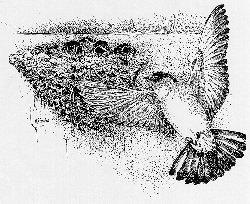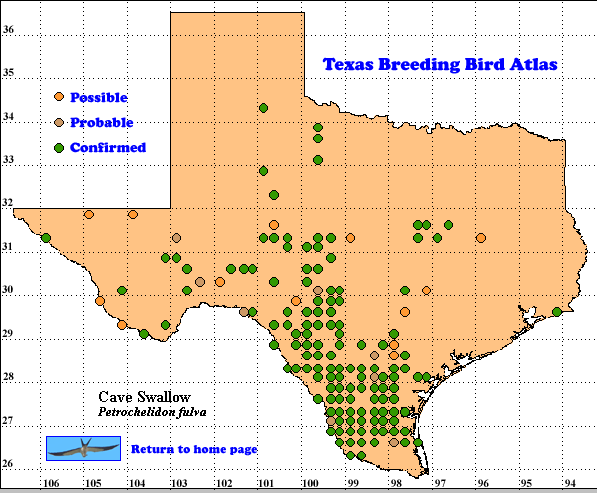Petrochelidon fulva
The Cave Swallow breeds from Texas and New Mexico, south through much of Mexico; in the western part of the Greater Antilles, east to Puerto Rico; and in South America in southwestern Ecuador and northwestern Peru (A. /O. U. 1983). Like the Cliff (P. pyrrhonota) and Barn (Hirundo rustica) swallows in Texas, beginning in the 1960s, the Cave Swallow rapidly expanded its breeding range. This expansion is strongly related to road-building practices which began within that time-frame.
DISTRIBUTION: In Texas the TBBA data illustrate the breeding range of the species from south Texas through much of south and east Edwards Plateau and north to Foard County, west to the Concho River valley, and through parts of the Trans-Pecos region. Until recently, the species was not known to nest east of U.S.77 in south Texas. Palmer (1988) reported colonies on or just east of that highway in 1986. In 1989, a small colony was discovered at Sea Rim State Park (latilong 29094).
SEASONAL OCCURRENCE: Because of the intensely colonial nature of this species and the unique architecture of the nest, the Cave Swallow can be easily confirmed as the adults swarm around the structure used for nesting. Of the 248 records reported to the TBBA, 79.7% were confirmed records. Of these reports, 179 (71.3% of the total) were active nests containing eggs or young, adults on the nest or in the nest-building stage.
Oberholser (1974) indicates a breeding season lasting from late February to early September; he records extreme egg dates of 5 April and 15 August, with a late date of 8 September for active nests. Martin (1974) reported incubation on 7 April and young in the nest on 8 September. The earliest nest with eggs among the TBBA data was recorded on 17 April 1990 for latilong 25098, quad G1. The latest reported date for a nest with eggs was 13 July 1987 in latilong 29099, quad H5. The latest date for nest with young was recorded on 31 July 1992 in latilong 32100, quad G8.
BREEDING HABITAT: Prior to the mid-1960s, the Cave Swallow bred in Texas only in sink holes on the Edwards Plateau and in caves in the Guadalupe Mountains (Oberholser 1974). Currently this swallow relies heavily upon man-made structures for nesting sites. The majority of the TBBA reports represent one or more nests in culverts under, or bridges over, roads. Buildings, either inhabited or abandoned, also receive some use by Cave Swallows, although these structures appear to be much less important for current Texas populations.
Today, the species continues to nest in sink holes in the southern Edwards Plateau and in caves and sink holes in the Trans-Pecos.
Like the Cliff Swallow, Cave Swallows build in close proximity to each other and, as the name implies, in caves. However, unlike Cliff Swallows, this species does not “stack” its nests on top of others: this likely comes from the open structure of the nest. Cave Swallows line their mud nests, built on sites with open approaches, with “..cotton-like plant fibers…thin strips of bark, fine grasses and feathers” (Selander and Baker 1957). Pairs likely raise two broods.
STATUS: The status of the Cave Swallow in Texas is excellent; the breeding distribution has expanded dramatically when compared with the map in Oberholser (1974). Selander and Baker (1957) summarized the breeding distribution as limited to caves in five counties on the southern part of the Edwards Plateau. Wauer and Davis (1972) reported the first nesting in Texas outside of the Edwards Plateau: in caves in Big Bend National Park. I found nesting Cave Swallows west of Fort Stockton in 1973 where I found them nesting with Barn Swallows (Hirundo rustica) in one culvert and with Cliff Swallows in another culvert (unpub. data). Martin (1974) noted the rapid expansion of the Cave Swallow by use of the highway culverts. He noted expansion of the swallow into south-central Texas from the locations plotted by Selander and Baker (1957). Furthermore, Martin (1974) reported widespread syntopic culvert nesting between Cave and Barn Swallows. Martin & Martin (1978) summarized the expansion of this species in south and west Texas. Finally, Palmer (1988) reported on continued expansion of Cave Swallows into south Texas, including the first nesting east of U.S. highway 77, the major north-south highway in that region; he also reported syntopic nesting of Cave, Cliff and Barn swallows. Palmer expressed concern that the Cave Swallow may be actually replacing the Cliff Swallow: current data suggest the two species have stabilized their populations in south Texas. Of more recent interest is the appearance of a small colony in extreme southeast Texas: latilong 29094, quad F1.
Text by Keith A. Arnold (ca. 1993)
Literature cited.
American Ornithologists’ Union. 1983. Checklist of North American birds,6th ed. Am, Ornithol. Union, Washington, DC.
Martin, R. F. 1974. Syntopic culvert nesting of Cave and Barn swallows in Texas. Auk 91: 776-782.
Oberholser, H. C. 1974. The bird life of Texas. University of Texas Press, Austin.
Palmer, P. C. 1988. Cave Swallow range continues to expand. Am. Birds 42: 174-176.
Selander, R. K. and J. K. Baler. 1957. The Cave Swallow in Texas. Condor 59: 345-363.
Wauer, R. H. and D. G, Davis. 1972. Cave Swallows in Big Bend National Park, Texas. Condor 74: 482.

